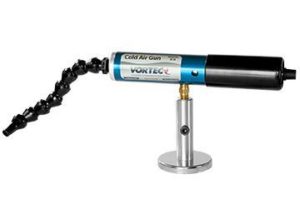Free shipping on all orders over $150! Use coupon code FREESHIP at check out
Cold Air Guns
C.C. Steven, your ANSWER to compressed air challenges.
Showing all 10 results
-
Sale!
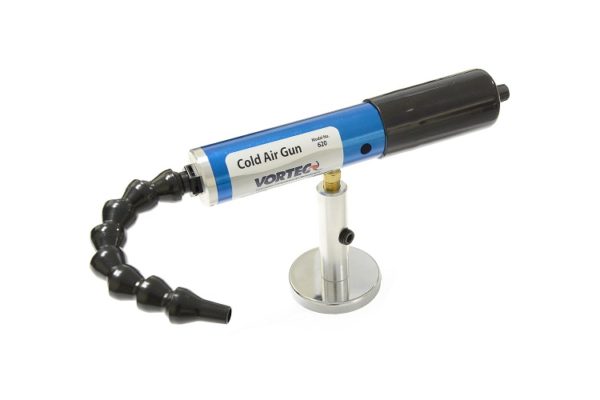
Adjustable Cold Air Gun Systems Models 610, 620, 630
$544.00 – $558.00 Select options -
Sale!
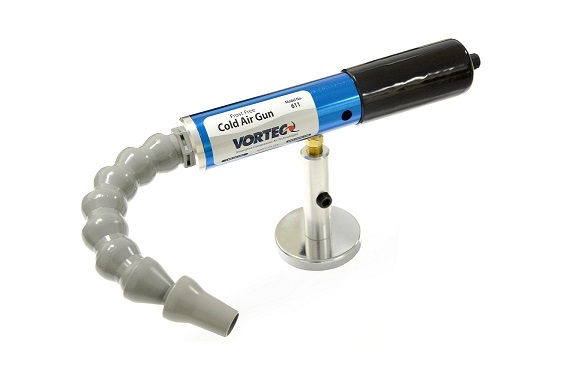
Adjustable Cold Air Gun Systems with Frost-free Nozzle
$597.00 – $612.00 Select options -
Sale!
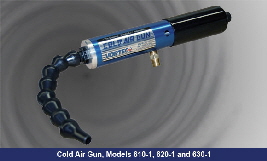
Adjustable Cold Air Gun only
$445.00$432.00 Select options -
Sale!
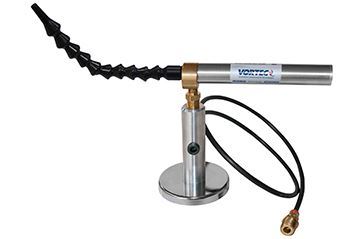
Vortex Mini Cold Air Gun 680
Rated 4.00 out of 5$405.00$393.00 Add to cart -
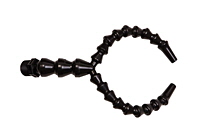
Model #: 610-30 Dual-Point Flexible Nozzle (two outlets) for 610, 620, and 630 Cold Air Guns
$54.00 Add to cart -
Sale!
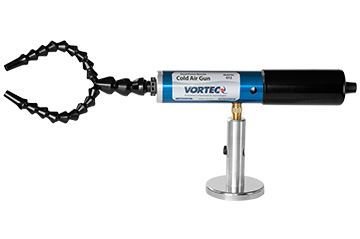
Dual Nozzle Cold Air Gun (VORTEC)
$447.00 – $582.00 Select options -
Sale!
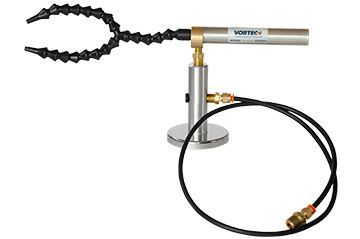
Dual Nozzle Mini Cold Air Gun (Vortec)
$435.00$422.00 Add to cart -
Sale!
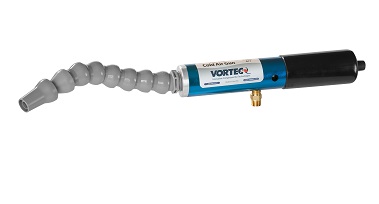
Adjustable Cold Air Gun Only with Frost-free Nozzle
$510.00$495.00 Select options -
Sale!

Vortex Mini Cold Air Gun- 680-1: (gun only) by Vortec
$335.00$325.00 Add to cart -
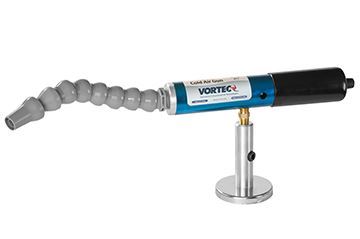
Model #: 611-FNU Frost-Free Flex-Line Nozzle
$84.00 Add to cart
Cold Air Guns
Cold Air Guns use filtered compressed air (80-100 PSIG) and vortex tube technology to produce sub-zero air for industrial spot cooling. Cold air machining eliminates mist coolants and heat-related parts growth while improving tool life, parts tolerance and surface finish quality. With no moving parts to wear out, Cold Air Guns require no electricity at the target, just a compressed air source.
Cold Air Guns are most often used for cooling of metal parts in the machining and repair of metals, plastics, wood, ceramics and other materials. Cold air machining outperforms mist coolants and substantially increases tool life and feed rates on dry machining operations. The effective cooling from a Cold Air Gun can eliminate heat-related parts growth while improving parts tolerance and surface finish quality.
Versatile Spot Cooling for Machining, Repair Shops and More
Cold Air Guns use vortex tube technology and filtered compressed air to produce sub-freezing air as low as -30 deg F (-34 deg C) for numerous industrial spot cooling applications. With no moving parts to wear out, Cold Air Guns require no electricity at the target, just a compressed air source.
Cold Air Guns are most often used for cooling of metal parts, in the machining and repair of metals, plastics, wood, ceramics and other materials. Cold air machining outperforms mist coolants and substantially increases tool life and feed rates on dry machining operations. The effective cooling from a Cold Air Gun can eliminate heat-related parts growth while improving parts tolerance and surface finish quality. Cold Air Guns have adjustable temperature and flow settings; and some models have a frost free nozzle to eliminate mess from frost and condensation.
Applications:
Cold Air Guns are used in various industrial processes, fabrication, assembly and packaging as a versatile spot cooling device. Most popular applications involve cooling during the machining of metals, plastics, wood, rubber, ceramics and other materials. Cold Air Guns provide effective cooling for most dry machining operations, allowing increases in feed rates and extending tool life. With no moving parts to wear out, the internal vortex tube converts factory compressed air into a sub-zero air stream, producing temperatures down to as much as -30°F.
- Widely used in milling, drilling, turning and other metalworking operations
- Machining of plastics, composites, wood and other materials
- Surface grinding, drill and tool sharpening
- CNC routers, blades and band saws
- Spot cooling of parts, molds and assemblies
- Industrial sewing and textiles
- Setting hot melts and adhesives
Features & Benefits
- Eliminates the mess, expense and safety concerns of using mist coolants
- Avoid secondary parts cleaning after machining
- Increases dry machining speed up to 36%
- Extends tool life up to 50%
- Low pressure air output helps clear chips and dust
- Reduces grinding wheel loading caused by overheating
- Cools parts to reduce normalization time and hold tight part tolerances
- Uses only filtered compressed air – no Freon required ( no CFCs/HCFCs)
- No EMI / RFI interference
- Creates cold air up to 70 F deg (39 C deg) below the inlet compressed air temperature
- Single turn adjustable temperature for your specific application
- Exceptionally reliable – no moving parts
- Quiet operation
- Magnetic base for easy installation and “machine-to-machine” portability
- Five micron filters included with Cold Air Gun Systems
- Meets OSHA noise and dead end pressure specifications
- Reduce waiting or normalization time by cooling parts faster
- Eliminate the potential for burning and scorching
- Avoid secondary parts cleaning after machining
- Reduce grinding wheel loading caused by overheating
- Highly reliable with no moving parts
- Uses only compressed air – no Freon
- System includes a magnetic base and a 5 micron auto-drain compressed air filter
- Magnetic base allows for easy, close in positioning and easy portability
SPECIFICATIONS
***680 Mini Cold Air Gun: Consumption 8 scfm, 227 SLPM, 400 BTU/hr, 101 KCal/Hr
611 -1 / 621 -1 / 631 – 1 = GUN ONLY MODELS
610 -1 / 620 -1 / 630 -1 = GUN ONLY MODELS
Other Products:
611-FNU = Frost-Free Flex-Line Nozzle
610-30 = Dual Point flexible nozzle (two outlets) for 610, 620, and 630 cold air guns!
| model # | 611 | 621 | 631 | 610 | 620 | 630 |
| Compressed air pressure (psig) | 80 – 100 | 80 – 100 | 80 – 100 | 80-100 | 80-100 | 80-100 |
| Inlet size (NPT pipe thread, inches) | 1/4 | 1/4 | 1/4 | 1/4 | 1/4 | 1/4 |
| Minimum Outlet Temperature, deg F
(at 70 deg F inlet air) |
-10 | 20 | 35 | -10 | 10 | 30 |
| Cooling Capacity (BTU/hr) | 900 | 1500 | 2500 | 900 | 1500 | 2500 |
| Air Consumption @ 100 psig (scfm) | 15 | 25 | 35 | 15 | 25 | 35 |
| Outlet Air Flow Rate (scfm) | 2 to 15 | 7 to 25 | 16 to 35 | 2 to 15 | 8 to 15 | 18 to 35 |
| Dimensions, inches | ||||||
| Overall Length | 19 5/8 | 19 5/8 | 19 5/8 | 18 5/8 | 18 5/8 | 18 5/8 |
| Diameter | 1 3/4 | 1 3/4 | 1 3/4 | 1 3/4 | 1 3/4 | 1 3/4 |
| Nozzle Length | 9 | 9 | 9 | 8 | 8 | 8 |
| Flexible Nozzle Diameter | 1 3/16 | 1 3/16 | 1 3/16 | 1 | 1 | 1 |
| Outlet Diameter (ID) | 3/8 | 3/8 | 3/8 | 3/8 | 3/8 | 3/8 |
| Magnetic base diameter | 3 3/16 | 3 3/16 | 3 3/16 | 3 3/16 | 3 3/16 | 3 3/16 |
| Magnetic base height | 4 1/8 | 4 1/8 | 4 1/8 | 4 1/8 | 4 1/8 | 4 1/8 |
| Weight, lbs | 3.0 | 3.0 | 3.2 | 3.0 | 3.0 | 3.2 |
| Supply hose | ||||||
| Diameter, inch | 3/8 | 3/8 | 1/2 | 3/8 | 3/8 | 1/2 |
| Maximum recommended distance, feet | 25 | 15 | 30 | 25 | 15 | 30 |
| Recommended filter size | 25 scfm | 25 scfm | 35 scfm | 25scfm | 25scfm | 35scfm |
| Filter model* | 701S-24A | 701S-24A | 701S-36A | 701S-24A | 701S-24A | 701S-36A |
680 – 1 = GUN ONLY MODEL
| model # | 612 | 622 | 632 | 680 | 682 |
| Compressed air pressure (psig) | 80 – 100 | 80 – 100 | 80 – 100 | 80-100 | 80-100 |
| Inlet size (NPT pipe thread, inches) | 1/4 | 1/4 | 1/4 | 1/4 | 3/8 |
| Minimum Outlet Temperature, deg F
(at 70 deg F inlet air) |
-10 | 10 | 30 | -10 | 10 |
| Cooling Capacity (BTU/hr) | 900 | 1500 | 2500 | 350 | 350 |
| Air Consumption @ 100 psig (scfm) | 15 | 25 | 35 | 8 | 8 |
| Outlet Air Flow Rate (scfm) | 2 to 15 | 8 to 25 | 18 to 35 | 4 | 3 |
| Dimensions, inches | |||||
| Overall Length | 18 5/8 | 18 5/8 | 18 5/8 | 13 1/4 | 13 1/4 |
| Diameter | 1 3/4 | 1 3/4 | 1 3/4 | 7/8 | 1 3/4 |
| Nozzle Length | 8 | 8 | 8 | 6 1/4 | 6 1/4 |
| Flexible Nozzle Diameter | 1 | 1 | 1 | 21/32 | 21/32 |
| Outlet Diameter (ID) | 3/8 | 3/8 | 3/8 | 1/8 | 1/8 |
| Magnetic base diameter | 3 3/16 | 3 3/16 | 3 3/16 | 3 3/16 | 3 3/16 |
| Magnetic base height | 4 1/8 | 4 1/8 | 4 1/8 | 4 1/16 | 3 1/16 |
| Weight, lbs | 3.0 | 3.0 | 3.0 | 1.3 | 1.3 |
| Supply hose | |||||
| Diameter, inch | 3/8 | 3/8 | 1/2 | 3/8 | 3/8 |
| Maximum recommended distance, feet | 25 | 15 | 30 | 80 | 25 |
| Recommended filter size | 25 scfm | 25 scfm | 35 scfm | 25 scfm | 25scfm |
| Filter model* | 701S-24A | 701S-24A | 701S-36A | 701S-24A | 701S-24A |
*Filter included with Cold Air Gun Systems
CASE STUDIES/Application Examples from Vortec!
CAROLINA PAPER CO.
Overview
The Carolina Paper Company (CPC), a 13-year old firm based in North Carolina, re-shapes large parent paper rolls into usable paper products including paper towels, napkins and toilet paper. CPC has a strong commitment to green business policies, designing everything from pallet configuration to product packaging to minimize waste, and working with paper vendors to reduce toxins. As a full line supplier of paper products, CPC emphasizes producing high quality paper products using sustainable methods.

The Challenge
As Carolina Paper Company’s Maintenance Manager, Ronald Laun is responsible for factory upkeep, preventative maintenance and ensuring optimal performance of all machines. The process of turning 55”diameter parent rolls into a small enough size to be used as paper towels and toilet paper involves rewinding as well as cutting the paper. Given the difference in size between the parent rolls and the finished product, the cutting process is extensive and can generate levels of heat which hinder equipment performance. Laun explains “In cutting our paper logs, we use a 40-inch diameter circular blade to saw through logs from 4” to 12” diameter at up to 50 cuts per minute. The sawing process creates a lot of friction and heat. Once you reach 100 degrees Fahrenheit, the blade begins to wobble and at that point it’s unsafe to continue cutting anymore. Our production was slowed down because we could only make a certain number of cuts to the log before having to take a break to permit the blade to cool.” By incorporating Vortec Cold Air Guns into their production, CPC was able to improve production by making, on average, 42% more cuts.“Another positive was that by keeping the blade cooler we didn’t scorch the ends of the final product. So in the end we increased production and quality.”
The Solution
Laun’s previous experience working in the textile field led him to see a possibility for enhancing this cutting process through the use of air products. He notes that “I knew if we could keep the blade cool, we could continue cutting for a longer period of time and that would improve production times. I went looking online for an air products company. I compared a few vendors, and Vortec stood out as innovators in their field—they pioneered the idea of vortex technology, so it made sense to go with them.”
Upon contacting Vortec, Laun was pleased that their engineers immediately grasped Carolina Paper Company’s need and were able to work with him to customize a solution. The Vortec 630 Cold Air Gun was retrofitted into the design of the log saw used to cut the large logs of paper. The cold, clean air supplied by the Vortec 630 Cold Air Gun guarantees that the temperature of the cutting blade remains cool enough to continue cutting for longer periods of time. Additionally, the dual nozzle enabled cooling of both sides of the blade, further improving the effectiveness of the Cold Air Gun in cooling the hot blade.

Conclusion
“Vortec’s technology is excellent and their people are very easy to work with” says Laun. “We are very pleased with our association with them.” After using Vortec’s Cold Air Gun for 3 months, Laun notes he has already extolled the virtues of Vortec’s products to other companies: “One of our other equipment manufacturers was at the factory and I showed him the retrofitting along with the data about how much our production had improved. He was very impressed.”
COOLING LARGE INDUSTRIAL PARTS IN 60 SECONDS
How do you take large industrial equipment from 350 to 100 degrees Fahrenheit in under 60 seconds?
This was the challenge faced by Anderson Machine Manufacturing, a Richmond, VA-based company which builds custom machines for a broad spectrum of industries and applications. In 2009, one of their clients, a multi national corporation, sought Anderson Machine’s aid in creating a machine to compress and cool the components of an industrial-size gear box shaft.

The client wanted extremely rapid cooling, so top of the line air equipment was a necessity. Since the components of the machine had to remain dry, mist cooling was not an option. Todd Anderson, Vice President and Mechanical Engineer at Anderson Machine, explains that “as a mechanical engineer, you know to do what you’re good at and find the best experts you can for other areas. We knew that in this case, meeting the client’s requirements meant finding an extremely high level of expertise in air technology.”
After learning about Vortec online, Anderson explained the machine his client sought. Vortec engineers analyzed the specifications Anderson provided and developed a solution. “Building as many different machines as we do, I deal with a lot of different vendors,” Anderson states. “With Vortec, they hit the ground running, grasping our needs right away instead of needing to have things explained to them twice. We told them how big the assembly was, what materials were involved and the timeframe. They performed the heat load calculations to determine which products would work, then sent a spreadsheet showing the products with the right cooling capacity.” By using four of Vortec’s model 610 Cold Air Guns, Anderson was able to deliver a machine which cooled the equipment quickly, meeting the client’s requirements.
Success breeds new challenges. Anderson’s clients were so pleased with the initial machine, that they requested a more advanced version. They wanted a machine capable of handling much larger pieces of equipment then their initial specifications had required. Anderson turned to Vortec for assistance in enhancing the design of the original machine to handle these new requirements.
Vortec’s engineers realized that, although the Cold Air Guns effectively cooled smaller equipment, a two-stage cooling process was necessary to bring down the temperature of the larger, denser equipment. They suggested that Anderson retrofit the machine, adding a preliminary cooling phase. Vortec also recommended shifting to the larger, more powerful model 630 Cold Air Guns rather than the smaller model 610’s which were originally used.

The 2-part cooling cycle necessary for the larger equipment involves using Vortec Curtain Transvector Air Knives to remove most of the heat, taking the temperatures of equipment from 350 to 150 degrees F. The Curtain Transvectors use compressed air, amplifying the air flow to rapidly dissipate heat by bringing more airflow (cubic feet perminute) to bear on the equipment. Curtain Transvector air knives bring more than three times the cooling capacity of standard nozzles. During this initial stage, machine operators can stop the process and take infrared temperature readings. In the second stage of the cooling process, four of Vortec’s Cold Air Guns model 630 cool the equipment, lowering the temperatures from 150 degrees F to under 110 degrees. The combination of the model 630 Cold Air Guns and Model 921 Curtain Transvector air knives bring the temperature of the large gear equipmentdown from 350 degrees to 100 degrees F in less than a minute.
“I give Vortec high marks,” Todd Anderson states. “When we presented them with an increased level of challenge based on our client’s new specs, they didn’t blink. The Vortec crew really has their heads screwed on right as far as interfacing with clients. And in addition to great products and an excellent understanding of technology, they also offer a very reasonable price.”
MAG: COLD AIR GUN AIDS IN AEROSPACE APPLICATIONS
Overview
The global corporation MAG offers a comprehensive line of equipment and technologies serving a wide range of industries including aerospace, automotive and truck, heavy equipment, oil and gas, rail, solar energy, wind turbine production and general machining. Their services include process development, automated assembly, turning, milling, automotive powertrain production, composites processing, maintenance, automation and software development. The company has facilities in the Americas, Asia and Europe. The headquarters for MAG Americas is located in Erlanger, KY and they have five main production facilities in North America, including one located in Hebron, KY, which is the center of excellence for composites technology.

The Challenge

Milo Vaniglia is Senior Project Engineer at the Hebron facility where he directs mechanical design of new products. Vaniglia’s team developed the company’s VIPER® Fiber Placement Systems (FPS). This composite fiber placement machine combines the advantages of tape laying and filament winding with advanced computer control and software. The fiber-reinforced graphite composite parts the VIPER® produces offers significant advantages over metal for the aerospace industry. Essentially, the VIPER® provides an effective method to make graphite/epoxy one-piece structures for aerospace applications.
The VIPER® machines have seven separate axes of motion, making them particularly suited to highly contoured structures such as cowls, ducts, fuselage sections, pressure tanks, nozzle cones, tapered casings, fan blades, spars and “C” channels. In developing this innovative system, Vaniglia realized that a cooling component was essential to prevent the tow or ribbon of composite tape from adhering to itself prior to placement, thus guaranteeing wrinkle-free, near net shape lay-up. In providing its high-profile aerospace customers with this technology, MAG demands excellence of all the components used in the VIPER® FPS. Vaniglia needed an air products company capable of meeting this challenge.
the VIPER® FPS. Vaniglia needed an air products company capable of meeting this challenge.
The Solution
Vaniglia chose Vortec because he was confident the company possessed the engineering expertise to meet the VIPER®’s need for cool air delivery. Vortec’s Cold Air Gun 610 converts compressed air into chilled air which conditions the pre-impregnated graphite fiber resin, resulting in the highest possible dexterity, flexibility and range for large to complex aerospace parts. “Vortec’s product makes it easier to dispense the pre-impregnated raw material,”Vaniglia notes.
How MAG Benefits From Vortec Products
“I have found Vortec to be very responsive to our needs,” Vaniglia observes. “They offer a product which is both consistent and versatile.” He notes that because the Vortec Cold Air Gun is so effective, MAG not only uses the product in all of the different models of VIPER® systems, but it has also increased the volume of Vortec products in each of these systems, using Cold Air Guns to cool other parts of the machine.
Conclusion
“We provide our clients with a high-quality machine, “Vaniglia states. “Vortec contributes a product which helps make our system excellent.“ The Senior Project Engineer, who has been using Vortec products since 1988, says he has found Vortec“very easy to work with. I would definitely recommend them.”
Sign Up For Our Newsletter

A name you can trust. Doing business since 1978!



